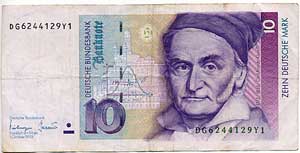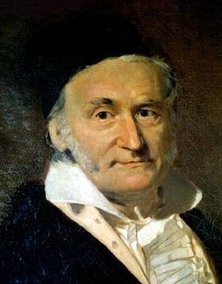Carl Friedrich Gauss
|
|
Johann Carl Friedrich Gauss (Gauß) (April 30, 1777 in Braunschweig - February 23, 1855 in Göttingen) was a legendary German mathematician, astronomer and physicist with a very wide range of contributions; he is considered to be one of the greatest mathematicians of all time.
| Contents |
Biography
Early years
Gaussportrait.jpg
Charcoal portrait of Carl Friedich Gauss
Gauss was born in Braunschweig, Duchy of Braunschweig-Lüneburg (now part of Lower Saxony, Germany), as the only son of lower-class uneducated parents. According to legend, his genius became apparent at the age of three, when he corrected, in his head, an error his father had made on paper while calculating finances. It is also said that while in elementary school, his teacher tried to occupy pupils by making them add up the (whole) numbers from 1 to 100. A few seconds later, to the astonishment of all, the young Gauss produced the correct answer, having realized that pairwise addition of terms from opposite ends of the list yielded identical intermediate sums: 1+100=101, 2+99=101, 3+98=101, etc., for a total sum of 50 × 101 = 5050. (see: summation) It however appears that the problem Gauss was given was more difficult and this anecdote has been told to students for the sake of maintaining "historic truth" [1] (http://mathforum.org/social/articles/ross.html)
The Duke of Brunswick awarded Gauss a scholarship to the Collegium Carolinum, which he attended from 1792 to 1795, and from there went on to the University of Göttingen from 1795 to 1798. While in college, he independently rediscovered several important theorems; his breakthrough occurred in 1796 when he was able to show that any regular polygon, each of whose odd factors are distinct Fermat primes, can be constructed by ruler and compass alone, thereby adding to work started by classical Greek mathematicians. Gauss was so pleased by this result that he requested that a regular 17-gon be inscribed on his tombstone. The stonemason declined, though, stating that the difficult construction would essentially look like a circle.
In fact, 1796 was probably the most famous year for Gauss and number theory itself: the construction of the heptadecagon was discovered on March 30th, his famous quadratic reciprocity law on April 8th, the prime number theorem conjectured on May 31st, he also discovered that every integer is representable as a sum of at most three triangular numbers on July 10th ("Heureka! num= <math>\Delta+ \Delta+\Delta<math>") and on October 1st published a result on the number of solutions of polynomials with coefficients in finite fields (This ultimately led to the Weil conjectures 150 years later).
Gauss was the first to prove the fundamental theorem of algebra, in his 1799 dissertation; in fact, he produced four entirely different proofs for this theorem over his lifetime, clarifying the concept of complex number considerably along the way.
Middle years

Gauss also made important contributions to number theory with his 1801 book Disquisitiones Arithmeticae, which contained a clean presentation of modular arithmetic and the first proof of the law of quadratic reciprocity. In that same year, Italian astronomer Giuseppe Piazzi discovered the planetoid Ceres, but could only watch it for a few days. Gauss predicted correctly the position at which it could be found again, and it was rediscovered by Franz Xaver von Zach on December 31, 1801 in Gotha, and one day later by Heinrich Olbers in Bremen. Zach noted that "without the intelligent work and calculations of Doctor Gauss we might not have found Ceres again." Though Gauss had up to this point been supported by the stipend from the Duke, he doubted the security of this arrangement, and also did not believe pure mathematics to be important enough to deserve support. Thus, following this path, he sought a position in astronomy, and in 1807 was appointed professor of astronomy and director of the astronomical observatory in Göttingen, which he held for the remainder of his life.
The discovery of Ceres and then of the planetoid Pallas by Olbers in 1802 led Gauss to his work on a theory of the motion of planetoids disturbed by large planets, published in 1809 under the name Theoria motus corporum coelestium in sectionibus conicis solem ambientum (theory of motion of the celestial bodies moving in conic sections around the sun). Among its contents were the introduction of the gaussian gravitational constant, and an influential treatment of the method of least squares, a procedure used in all sciences to this day to minimize the impact of measurement error. He was able to prove the correctness of the method under the assumption of normally distributed errors (see Gauss-Markov theorem; see also Gaussian). The method had been described earlier by Adrien-Marie Legendre in 1805, but Gauss claimed that he had been using it since 1795.
Gauss had been asked in 1818 to carry out a geodesic survey of the state of Hanover to link up with the existing Danish grid. Gauss was pleased to accept and took personal charge of the survey, making measurements during the day and reducing them at night, using his extraordinary mental capacity for calculations. He regularly wrote to Schumacher, Olbers and Bessel, reporting on his progress and discussing problems. Because of the survey, Gauss invented the heliotrope which worked by reflecting the Sun's rays using a of mirrors and a small telescope. However, inaccurate base lines were used for the survey and an unsatisfactory network of triangles.
Gauss also stated that he had discovered the possibility of non-Euclidean geometries before everybody else but that he never published it. His friend Farkas (Wolfgang) Bolyai (with whom Gauss had sworn "brotherhood and the banner of truth" as a student) had tried in vain for many years to prove the parallel postulate from Euclid's other axioms of geometry and failed. Bolyai's son, János Bolyai, discovered non-Euclidean geometry in 1829; his work was published in 1832. After seeing it, Gauss wrote to Farkas Bolyai: "To praise it would amount to praising myself. For the entire content of the work ... coincides almost exactly with my own meditations which have occupied my mind for the past thirty or thirty-five years ." This unproved statement (that nonetheless nowadays is generally taken at face value) understandably put a strain on his relationship with János Bolyai (who thought that Gauss was "stealing" his idea).
In 1818, Gauss started a geodesic survey of the state of Hanover, work which later led to the development of the normal distribution for describing measurement errors and an interest in differential geometry and his theorema egregrium establishing an important property of the notion of curvature.
Later years, death, and afterwards
GaussBust.jpg
In 1831, a fruitful collaboration with the physics professor Wilhelm Weber developed, leading to results about magnetism (including finding a representation for the unit of magnetism in terms of mass, length and time) and the discovery of Kirchhoff's circuit laws in electricity. Gauss and Weber constructed the first electromagnetic telegraph in 1833, which connected the observatory with the institute for physics in Göttingen. Gauss ordered a magnetic observatory to be built in the garden of the observatory and with Weber founded the magnetischer Verein ("magnetic club"), which supported measurements of earth's magnetic field in many regions of the world.
He died in Göttingen, Hanover (now part of Lower Saxony, Germany) in 1855 and is interred in the cemetery Albanifriedhof there.
Gauss' brain was preserved and was studied by Robert Wagner who found its weight to be 1,492 grams and cerebral area equal to 219,588 square centimeters. There were also found highly developed convolutions, in which perhaps lies the explanation of his genius.
Personal life
Although Gauss never worked as a professor of mathematics and disliked teaching (it is said that he only attended a single scientific conference, which was in Berlin in 1828), several of his students turned out to be influential mathematicians, among them Richard Dedekind and Bernhard Riemann.
Gauss was deeply religious and conservative. He supported monarchy and opposed Napoleon whom he saw as an outgrowth of revolution. Gauss' personal life was overshadowed by the early death of his beloved first wife, Johanna Osthoff, in 1809, soon followed by the death of one child, Louis. Gauss plunged into a depression from which he never fully recovered. He married again, to Friederica Wilhelmine Waldeck (Minna), but the second marriage does not seem to have been very happy. When his second wife died in 1831 after long illness, one of his daughters, Therese, took over the household and cared for Gauss until the end of his life. His mother lived in his house from 1812 until her death in 1839. He rarely if ever collaborated with other mathematicians and was considered aloof and austere by many.
Gauss had six children, three by each wife. With Johanna (1780–1809), his children were Joseph (1806–1873), Wilhelmina (1808–1846) and Louis (1809–1810). Of all of Gauss' children, Wilhelmina was said to have come closest to his talent, but regrettably, she died young. With Minna Waldeck, a friend of Johanna's whom he married after her death, he had three children: Eugene (1811–1896), Wilhelm (1813–1879) and Therese (1816–1864). Eugene immigrated to the United States about 1832 after a falling out with his father, eventually settling in St. Charles, Missouri, where he became a well respected member of the community. Wilhelm came to settle in Missouri somewhat later, starting as a farmer and later becoming wealthy in the shoe business in St. Louis. Therese kept house for Gauss until his death, after which she married.
Commemorations of Gauss
From 1989 until the end of 2001, his portrait and a normal distribution curve were featured on the German ten-mark banknote.
G. Waldo Dunnington was a life-long student of Gauss. He wrote many articles, and a biography: Carl Frederick Gauss: Titan of Science. This book was re-issued in 2003, after having been out of print for almost 50 years.
See also
Further reading
- Simmons, J, The giant book of scientists -- The 100 greatest minds of all time, Sydney: The Book Company, (1996)
- Dunnington, G. Waldo, Carl Friedrich Gauss: Titan of Science, The Mathematical Association of America; (June 2003)
- Carl Friedrich Gauss tr. Arthur A. Clarke: Disquisitiones Aritmeticae, Yale University Press, 1965 ISBN 0300094736
References and external links
- Template:Planetmath reference
- Carl Friedrich Gauss (http://www.geocities.com/RainForest/Vines/2977/gauss/english.html), comprehensive site including biography and list of his accomplishments
- Friedrich Gauss (http://www.corrosion-doctors.org/Biographies/GaussBio.htm|title=Carl)
- Template:MacTutor Biography
- Carl Frederick Gauss (http://www.mathsong.com/cfgauss), site by Gauss' great-great-great granddaughter, including a scanned letter written to his son, Eugene, and links to his genealogy.
- Gauss and His Children (http://www.gausschildren.org), site for Gauss researchers and descendants of Gauss.
- Gauss (http://www.gauss.info), general information, submit your site about Gauss.
- Carl Friedrich Gauss (http://fermatslasttheorem.blogspot.com/2005/06/carl-friedrich-gauss.html), covers topics in the history of Fermat's Last Theorem from Diophantus of Alexandria to Andrew Wiles.
- The Sesquicentennial of the Birth of Gauss (http://www.mathsong.com/cfgauss/Dunnington/1927/), comprehensive biogrophical article.
Obituaries
- MNRAS 16 (1856) 80 (http://adsabs.harvard.edu//full/seri/MNRAS/0016//0000080.000.html)bg:Карл Фридрих Гаус
bn:কার্ল ফ্রিডরিক গাউস de:Carl Friedrich Gauß es:Carl Friedrich Gauss fr:Carl Friedrich Gauss id:Carl Friedrich Gauss it:Carl Friedrich Gauss he:קרל פרידריך גאוס ko:카를 프리드리히 가우스 nl:Carl Friedrich Gauss ja:カール・フリードリヒ・ガウス no:Carl Friedrich Gauss pl:Carl Friedrich Gauss pt:Carl Friedrich Gauss ru:Гаусс, Карл Фридрих sl:Carl Friedrich Gauss fi:Carl Friedrich Gauss sv:Carl Friedrich Gauss th:คาร์ล ฟรีดริช เกาส์ zh:卡爾·弗里德里希·高斯

